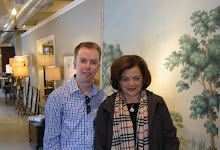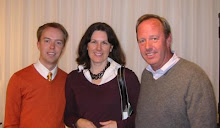
Yet another interesting not so small house from "Small country houses of to-day" is Upmeads, designed by Edgar Wood in 1908.

Like many of the other houses in the book, the house has been lovingly cared for in private hands and remains in nearly the exact condition in which it was built.

Down to the monogram of the original owners who commissioned the house above the front door.

The only change I can see is that a chauffeur's apartment has been sympathetically added on top of the original garage in the forecourt.

The house is shocking for its' base modernity. Can you believe this was built in 1908?

Flat roofed with a boxy plan, it is a hint of what was to come in the future.

Perhaps the house was a bit before its time even as Weaver proclaims in the book "
The house is unusual to the point of oddness".

Even the rear terrace remains intact.

Lets step inside to the original interiors (as far as I can tell). The entryway features beautifully softly groin-vaulted ceilings and herringbone oak floors.

Doors have been installed between the original hall and vestibule in favor of curtains (one of the concessions to the time period).

Weaver makes much of the custom fireplace mantels in the book and they still exist.

I love being able to find these color photos to fill in the blanks left behind by the B&W photos.

The
lincrusta and other wallpaper found throughout the house appear to not be original.

The groin vaulting continues in the 2nd floor hall.

New heating systems have obviously been installed.

More lincrusta upstairs.

Color images and some history found via
Manchester History and interior photography via
Andy Marshall.
 Yet another interesting not so small house from "Small country houses of to-day" is Upmeads, designed by Edgar Wood in 1908.
Yet another interesting not so small house from "Small country houses of to-day" is Upmeads, designed by Edgar Wood in 1908. Like many of the other houses in the book, the house has been lovingly cared for in private hands and remains in nearly the exact condition in which it was built.
Like many of the other houses in the book, the house has been lovingly cared for in private hands and remains in nearly the exact condition in which it was built.  Down to the monogram of the original owners who commissioned the house above the front door.
Down to the monogram of the original owners who commissioned the house above the front door.  The only change I can see is that a chauffeur's apartment has been sympathetically added on top of the original garage in the forecourt.
The only change I can see is that a chauffeur's apartment has been sympathetically added on top of the original garage in the forecourt.  The house is shocking for its' base modernity. Can you believe this was built in 1908?
The house is shocking for its' base modernity. Can you believe this was built in 1908? Flat roofed with a boxy plan, it is a hint of what was to come in the future.
Flat roofed with a boxy plan, it is a hint of what was to come in the future. Perhaps the house was a bit before its time even as Weaver proclaims in the book "The house is unusual to the point of oddness".
Perhaps the house was a bit before its time even as Weaver proclaims in the book "The house is unusual to the point of oddness".  Even the rear terrace remains intact.
Even the rear terrace remains intact. Lets step inside to the original interiors (as far as I can tell). The entryway features beautifully softly groin-vaulted ceilings and herringbone oak floors.
Lets step inside to the original interiors (as far as I can tell). The entryway features beautifully softly groin-vaulted ceilings and herringbone oak floors. Doors have been installed between the original hall and vestibule in favor of curtains (one of the concessions to the time period).
Doors have been installed between the original hall and vestibule in favor of curtains (one of the concessions to the time period). Weaver makes much of the custom fireplace mantels in the book and they still exist.
Weaver makes much of the custom fireplace mantels in the book and they still exist.  I love being able to find these color photos to fill in the blanks left behind by the B&W photos.
I love being able to find these color photos to fill in the blanks left behind by the B&W photos. The lincrusta and other wallpaper found throughout the house appear to not be original.
The lincrusta and other wallpaper found throughout the house appear to not be original. The groin vaulting continues in the 2nd floor hall.
The groin vaulting continues in the 2nd floor hall. New heating systems have obviously been installed.
New heating systems have obviously been installed. More lincrusta upstairs.
More lincrusta upstairs. Color images and some history found via Manchester History and interior photography via Andy Marshall.
Color images and some history found via Manchester History and interior photography via Andy Marshall.









































.JPG)








































































15 comments:
It IS a great house for its time. There seems to be some influence by Lutyens, and that is always a plus for me.
I find the misconception among non-design types that modernism was a flaw of the 1950's, so amusing. I do find the exterior of that house odd but the interiors rather pleasing. Thanks for the introduction to one I was not familiar with.
"Groin-vaulted" is a new term to me, but I love what it describes, especially the 9th picture down, of the hall.
It is such an interesting place. The exterior is so deco yet also has faint echos of houses from hundreds of years earlier.
I love that first fireplace with that eccentric combination of marble.
I don't like the 2-tone room very much... the door just feels wrong. Still, the entry is marvelous. Thanks for another great tour!
It reminds me of my elementary school. I love the images you have shared. I shall have a look further....
pve
Totally surprising and intriguing, this building.
I agree with The Devoted Classicist, that Lutyens springs to mind, but does anyone know exactly who
designed this house? Unusual to the point of oddness
is a very apt description. The lack of fenestration on
the entrance facade would suggest an institution rather
than a residence~or perhaps an enlightened version of a penitentiary ?
Hi, Stefan - I've studied this house for the longest time, trying to figure out to what other style it might harken. Such an odd placement of windows. Like pve design, I was reminded of a public school I attended, and then it hit me! This reminds me of the Anasazi ruins in Chaco Canyon, or the later Pueblo dwellings. Can you see it built into the side of a cliff?
The architect's name is Wood.
Without the date, I would have guessed it to have been built in the 20's, so moderne are the facades---a great surprise.
I don't find it completely beautiful, but I do find it completely fascinating
It seems quite institutional on the outside - reminds me of some of my least favorite buildings at my alma mater, Rice University.
Fascinating to see some of the old and new pictures! I could not make out the words on the space to the right of the vestibule, the area that leads to a dead end WC - but it looks like closets? I like that the stairs are tucked a bit to the side but still central.
The upstairs seems to have very low ceiling heights!
Loved reading this post and analyzing the pictures.
- Holly
Great improvements. Things remain the same but the style change. All are looking more attractive than before with extra features added.
What an interesting house. It seems a bit Spartan on the exterior but the interior is very warm and bright and I actually really like it. Very unique.
Stefan a home like this was built in one of our historic neighborhoods and everyone was aghast at the time. I have been in it during two different owners and have to say it is quite unique.
I love the interior groin vaulting, archways, and those wonderful aged oak herringbone floors!
xoxo
Karena
Art by Karena
i think this place is fabulous.
i love flat roofed homed.
but,the architecture inside is amazing and quite a surprice.
;)
I thoroughly recommend people check out the 2012-published article on Edgar Wood by David Morris in the University of Manchester's John Rylands Bulletin. Do not under-estimate this architect's importance - he was highlighted as a 'famous architect' alongside only Richard Norman Shaw, Philip Webb, Voysey and Baillie Scott in a 1904 review of Das Englische Haus in 'The Studio'. The formation of the Modernist canon in the 1930s did him very few favours (always question the canon people - Only Loos, CRM, Hoffman, Irving Gill and FLW were being this avant-garde in 1908). Pevsner rather belatedly recognised Wood's importance and really should have written him in to later editions of 'Pioneers' (see his 'Nine Swallows, No Summer' from 1942 and his entries for Upmeads and First Church of Christ Scientist in later 'Buildings of England'). I'd even caution against assumptions Wood followed Lutyens (Lutyens designed Abbey House in 1910, shortly after working with Wood on the Hampstead Garden suburb project.. he'd have known the older Wood's flat-roofed proto-modernism). Wood was of course a 'provincial' Manchester architect. In 1907-08 Manchester was wasting its communal energy on developments such as the Rolls Royce Silver Ghost, AV Roe's first aircraft, Beyer-Garratt Locomotion, Rutherford's atomic studies, women's suffrage (I'll stop there.. you can throw in Adolph Valette and the public debut of Elgar's 1st somewhere further down). Oh, and Charles Holden knew him.. no doubt very well. Shame so much Arts and Crafts evidence ended up in flames (see Eitan Karol, 2007).
Post a Comment